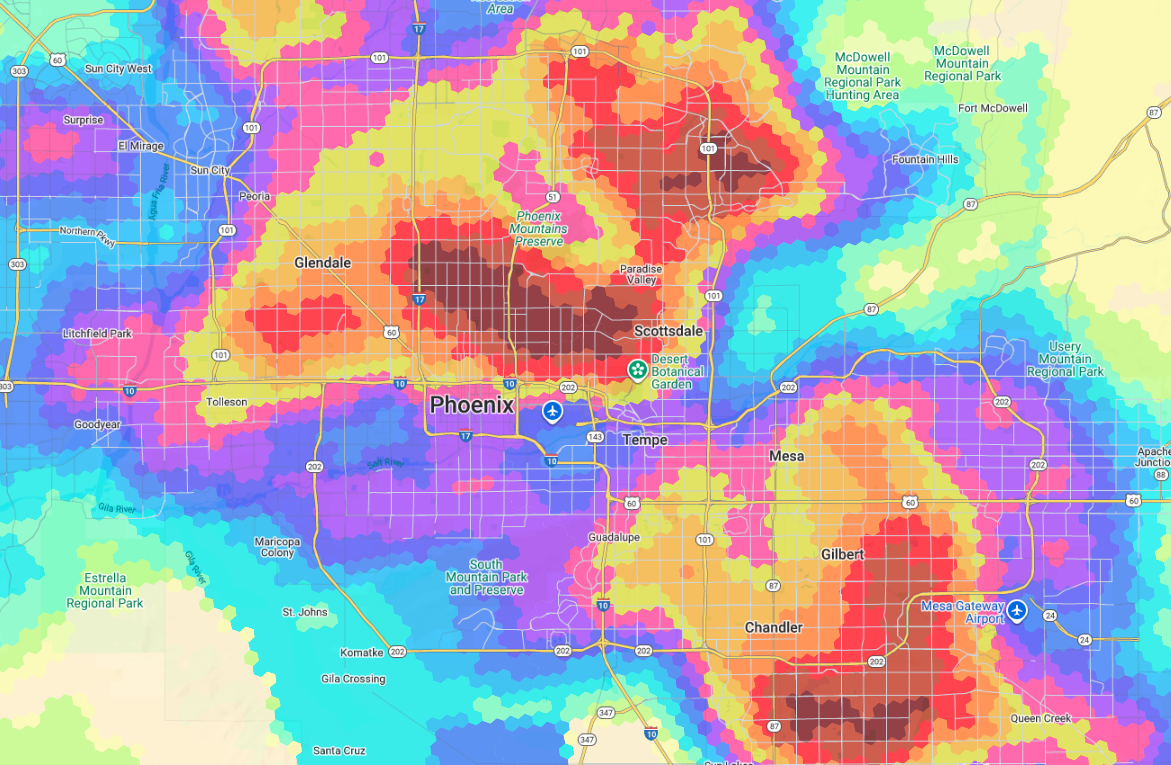Phoenix’s Competitive Edge: Growth, Talent, and Education
Executives evaluating where to expand or relocate their business are increasingly looking toward Phoenix—a city now defined by strategic growth, a strong workforce pipeline, and proximity to Arizona’s leading research universities, including Arizona State University in Tempe and the University of Arizona’s Phoenix Biomedical Campus.
One major driver of that momentum is the University of Arizona’s ongoing capital investment strategy. This $400 million FY 2025 plan reinforces the region’s position as a hub for research, innovation, and workforce development.
Photo Credit: The University of Arizona
The University of Arizona Expansion Plans & Investment Scope
FY 2025 – 2028 Capital Improvement Plan (CIP)
According to the Arizona Board of Regents, the University of Arizona has proposed $400 million in capital investments for FY 2025. These include three transformative projects:

Photo credit: McCarthy + SmithGroup
-
Center for Advanced Molecular and Immunological Therapies (CAMI) – A 245,000 SF facility designed to advance biomedical engineering and immunotherapy research.
-
New Art Museum for Fine Arts – Expanding cultural and educational capacity on campus.
-
Human-Animal Interaction (HAI) Research Facility – Supporting veterinary and translational science within the College of Veterinary Medicine.
These initiatives demonstrate the university’s commitment to cutting-edge research and cross-disciplinary innovation—key indicators of a thriving business ecosystem.
Infrastructure Renewal & Maintenance
The FY 2025 CIP also requests $129.4 million in building renewal funding under state formulas, ensuring U of A maintains safe, modern, and efficient campus operations. This level of reinvestment signals long-term institutional stability—an important factor for companies evaluating nearby real estate opportunities.
FY 2026 – 2029 Forward Planning
The FY 2026–2029 plan introduces $60 million in new first-year projects, emphasizing high-priority improvements and modernization. Funding is expected to come from university bonds and other internal sources, with overall planned capital investments through FY 2029 totaling approximately $460 million across multiple projects.
(Source: Arizona Board of Regents FY 2025–2028 and FY 2026–2029 Capital Improvement Plans.)
Why This Matters for Phoenix Growth & the Regional Economy
Bioscience & Healthcare Expansion
The CAMI facility is a catalyst for bioscience development across Greater Phoenix. It will strengthen Arizona’s role in advanced medical research and attract both academic and private-sector investment—driving growth in specialized commercial real estate.
Cultural Infrastructure & Placemaking
The new art museum enhances U of A’s cultural footprint, boosting mixed-use demand and enriching local placemaking. For developers and employers, this kind of investment elevates surrounding neighborhoods and creates amenity-rich environments that appeal to top talent.
Campus Modernization & Innovation Ecosystems
The university’s ongoing modernization projects expand Arizona’s research capacity across biomedical, engineering, and interdisciplinary fields. These intersections often generate startup formation and public-private partnerships, strengthening the regional innovation ecosystem.
Institutional Stability
Deferred-maintenance investments show a focus on long-term campus reliability—supporting not only academic success but also commercial partnerships and real estate confidence in nearby markets.
Phoenix Workforce: Recruiting in a Region on the Rise
Phoenix continues to rank among the fastest-growing metropolitan areas in the United States. This growth translates directly into recruiting advantages for employers seeking skilled, diverse talent.
-
Projected Population Growth: Greater Phoenix is expected to grow from approximately 5 million to 5.7 million residents by 2029.
-
Employment Growth: Forecasted job growth exceeds 13% over the next decade—nearly twice the national average.
-
Education Pipeline: With more than 40 universities, community colleges, and training programs, the Phoenix workforce is continuously replenished with skilled graduates.
-
Active Workforce Support: Programs like ARIZONA@WORK partner with employers to design upskilling and recruitment solutions.
From semiconductors to bioscience, Phoenix’s expansion is powered by both public-sector investment and private-sector collaboration. The University of Arizona’s expansion reinforces that momentum, signaling confidence in Arizona’s long-term economic outlook.
What Business & CRE Leaders Should Do Next
-
Target Strategic Zones
Focus on sites near institutional projects—particularly along the Phoenix Bioscience Core and university-adjacent areas that benefit from new infrastructure. -
Engage Early on Workforce Strategy
Tie location strategy to local universities and training programs to improve recruiting efficiency and retention. -
Evaluate Economic Impact Data
Request or review impact studies to assess job-creation multipliers and commercial demand near major projects like CAMI. -
Partner with Occupier Services Commercial Real Estate Advisor, like Keyser Commercial Real Estate
Whether you’re planning to relocate or expand your office, industrial, medical / healthcare, semiconductor, or bioscience operations, Keyser Commercial Real Estate provides the strategic advisory, site selection, and tenant representation expertise needed to make informed, future-proof decisions.
Conclusion
Arizona’s growth story is no longer speculative—it’s measurable, strategic, and accelerating. The University of Arizona’s expansion highlights the region’s deep investment in education, research, and innovation, strengthening the foundation for business success.
For executives assessing relocation or expansion, Phoenix offers a unique intersection of growth, affordability, and talent access—and Keyser stands ready to guide your organization through every phase of that journey.
Disclaimers
This publication is for informational purposes only and is not intended as legal, financial, or real estate advice. Information sources include the Arizona Board of Regents, University of Arizona public documents, and publicly available economic data as of 2025. All projections are subject to change based on market and institutional conditions.
Citations
-
Arizona Board of Regents FY 2025–2028 Capital Improvement Plan (PDF)
-
Arizona Board of Regents FY 2026–2029 Capital Improvement Plan (PDF)
-
InBusiness PHX – Universities Fueling Arizona’s Economic Growth





